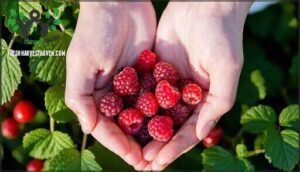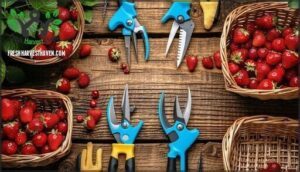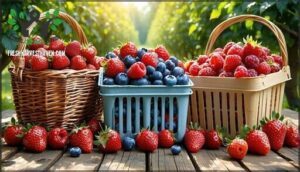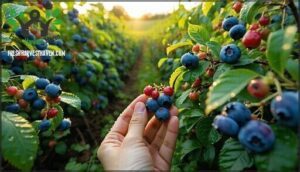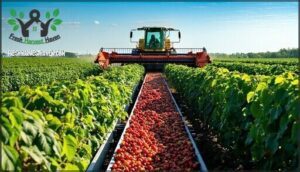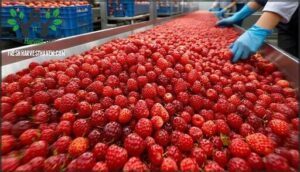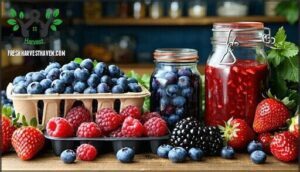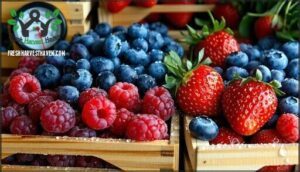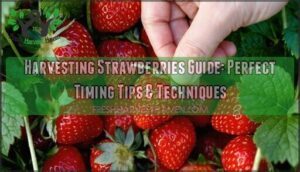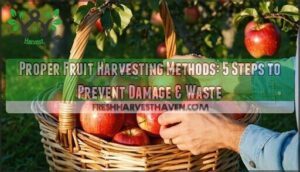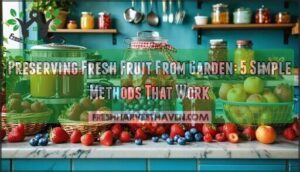This site is supported by our readers. We may earn a commission, at no cost to you, if you purchase through links.
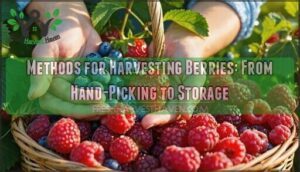 The difference between a bruised berry that spoils in a day and one that stays fresh for a week often comes down to a single moment: how you pick it. When you harvest berries, you’re making dozens of split-second decisions that affect flavor, shelf life, and market value.
The difference between a bruised berry that spoils in a day and one that stays fresh for a week often comes down to a single moment: how you pick it. When you harvest berries, you’re making dozens of split-second decisions that affect flavor, shelf life, and market value.
Each berry type demands its own approach—strawberries need a gentle twist, blueberries respond to a rolling motion, and raspberries practically tell you when they’re ready by sliding off their cores.
The methods for harvesting berries you choose will determine whether your crop reaches consumers at peak quality or deteriorates before it leaves your farm.
Table Of Contents
- Key Takeaways
- Harvesting Berry Types
- Berry Ripeness Indicators
- Hand-Picking Berries
- Machine Harvesting Methods
- Post-Harvest Handling
- Berry Storage Techniques
- Transportation Methods
- Maintaining Berry Freshness
- Frequently Asked Questions (FAQs)
- How do you harvest berries?
- How do commercial farms harvest blueberries?
- How long should you soak berries to clean them?
- What to use for berry picking?
- How do you harvest common types of berries?
- How should berries be handled after harvest?
- How much berries should you harvest?
- How do you harvest fruit from a tree?
- How do you pick ripe berries?
- When to harvest berries?
- Conclusion
Key Takeaways
- Proper harvesting techniques vary by berry type—strawberries need a gentle twist at the stem, blueberries respond to rolling motions, raspberries slip off when ready through core separation, and blackberries signal ripeness by turning dull black.
- Timing and temperature control are critical for quality—harvest in cool morning hours when berries are firm, immediately cool them to 32-40°F within two hours, and maintain 90-95% humidity to prevent spoilage and extend shelf life.
- Mechanical harvesting can reduce labor by up to 60-fold and cut costs by 85% for operations over 70 acres, though it requires careful calibration of shaking mechanisms and soft-catch technology to minimize bruising and fruit damage.
- Post-harvest handling directly impacts market value—proper sorting, ventilated containers, rapid cooling, and quality monitoring at multiple checkpoints preserve berry freshness and prevent the 20% losses some regions face from poor handling practices.
Harvesting Berry Types
Each berry variety comes with its own set of harvesting signals and techniques. Knowing these differences helps you pick at the right moment and treat each type properly.
Let’s look at what makes strawberries, blueberries, raspberries, and blackberries unique regarding harvest time.
Strawberry Harvesting Methods
Picking strawberries is like catching them at the peak of a perfect summer day—timing and touch make all the difference. Look for berries with vibrant red color and sweet aroma—these show ideal timing for harvesting berries.
When handpicking, grasp the stem above the fruit and gently pinch or cut it, preserving the green cap. Careful treatment prevents bruising and maintains quality.
Harvest during cool mornings when berries are firm, and place them in shallow containers to avoid crushing. Quick field inspections help you select only the ripest fruit while field conditions remain ideal.
Blueberry Harvesting Techniques
Blueberries have a reputation for being tougher than strawberries, but they’re actually just as delicate once they ripen. You’ll know they’re ready when they turn deep blue with that silvery bloom covering the skin. Bloom removal during picking damages the natural protective coating, so treat each berry with care.
Master these blueberry harvesting techniques:
- Check berry firmness by rolling fruit gently between your fingers—ripe ones detach easily
- Harvest during early morning hours when berries are cool and firm
- Use rake harvesting or gentle bush shaking to speed collection without bruising
- Store picked berries immediately in shallow containers with proper storage conditions
Timing your harvest correctly guarantees the best flavor and longest shelf life for your crop.
Raspberry Picking Strategies
Raspberries slip off their cores when they’re ready, making them easier to pick than their thorniest reputation suggests. You’ll want to master Cane Management by identifying productive canes first. Navigate through your patch systematically to avoid getting tangled in dense growth. Thorns Avoidance is essential—wear long sleeves and sturdy gloves for protection.
Watch for Core Separation as your key indicator. When berries detach with barely any pressure, they’re perfect. Variety Differences matter too—some cultivars ripen faster than others. Picking Frequency should increase to every couple of days during peak season.
Use careful treatment during raspberry picking to prevent crushing these delicate fruits. Early morning harvesting techniques work best when ripe berries are cool and firm. Always use shallow containers to protect your harvest from damage.
Blackberry Harvesting Tips
While raspberries rely on core separation as your signal, blackberries give you a different clue—they turn dull black and lose their shine when they’re ready to leave the vine. These ripe berries detach with minimal pressure during harvest timing.
Wear gloves for thorn protection even with thornless varieties. Understanding ripeness stages prevents picking too early.
Use careful treatment and storage preparation immediately after blackberry harvesting to maintain quality throughout the harvesting season.
Berry Ripeness Indicators
Knowing when your berries are ready makes all the difference between a sweet harvest and a disappointing one. You’ll want to check three key signs that tell you it’s picking time.
Let’s look at how color, smell, and touch work together to guide your harvest decisions.
Color Change Signs
Once you’ve identified which berries to harvest, spotting the right color change signs becomes your roadmap to perfect ripeness. Each berry type shows distinct hue variations as pigment changes signal different ripening stages.
Look for color uniformity across the entire fruit—ripe berries display consistent shading without green patches. This visual sorting helps you time your harvest perfectly and assures berry storage potential.
Aroma Development
The fragrance wafting from a berry patch tells you more about ripeness than any chart or calendar ever could. As berries move through ripening stages, aroma compounds intensify and shift in character. Strawberries release sweet, candy-like notes when fully ripe, while raspberries develop rich, jammy fragrances. Blueberries offer subtle wine-like scents at peak maturity.
These aroma indicators serve as reliable harvesting cues—you’ll notice fragrance changes most clearly during cool morning hours when volatile compounds haven’t dispersed. Trust your nose to guide harvest timing, as intensely aromatic ripe berries also signal prime fruit quality for proper storage. Strong fragrance means finer flavor and better performance under refrigeration techniques.
Texture Checks
Your fingertips hold the secret to knowing when berries have reached their peak ripeness. Firmness Assessment starts with gentle pressure—ripe berries yield slightly but bounce back, showing healthy Turgidity Levels. Hard berries need more time, while mushy ones are past prime. Softness Detection requires a delicate roll between your fingers to check for that perfect give without triggering Bruising Prevention concerns.
Proper berry treatment during these texture checks protects fruit quality throughout harvesting techniques. Press the berry’s shoulder, not the tip, to avoid damage. Careful treatment prevents the crushing that compromises both appearance and shelf life.
- Test firmness with light thumb pressure on the berry’s sides
- Roll berries gently to detect internal softness while maintaining Damage Control
- Watch for skin that’s taut but not tight—a sign of ripeness
- Stop checking immediately if you feel mushiness—those berries won’t store well
Trust your touch when harvesting berries. It’s your most reliable tool for perfect timing.
Hand-Picking Berries
Hand-picking berries requires skill and care to protect both the fruit and the plant. The right approach makes all the difference in harvest quality and efficiency.
Let’s look at the key practices that’ll help you pick berries like a pro.
Gentle Handling Techniques
Think of each berry like a water balloon—one wrong squeeze and you’ve made juice instead of keeping treasure. Roll berries gently between your fingertips instead of pinching them. This gentle touch prevents bruising better than any other method.
Treat each berry like a water balloon—roll it gently between your fingertips instead of pinching to prevent bruising
Pinch the stem close to the fruit, then twist lightly for proper berry care. Use shallow containers to avoid crushing your harvest.
Delicate varieties like raspberries need extra care—they’ll reward your gentle touch with perfect fruit that lasts longer.
Tool Selection
Choosing the right tools isn’t just about grabbing what’s handy—it’s about protecting your harvest while saving your back from unnecessary strain. Smart berry harvesting equipment makes every picking session more productive:
- Glove materials – Select puncture-resistant options for thorny varieties
- Pruner selection – Sharp blades guarantee clean stem cuts
- Rake types – Specialized berry rakes speed up blueberry collection
- Basket design – Shallow containers with ventilation prevent crushing
Picking ergonomics matter more than you’d expect. Invest in harvesting tools that reduce repetitive motions.
Regular harvesting equipment maintenance keeps everything working smoothly season after season.
Container Choices
Pick the wrong container and watch your carefully harvested berries turn to mush before they even reach the kitchen. Container choices directly impact postharvest care success. Shallow containers prevent crushing when ripe berries pile up. Breathability factors matter—wicker or ventilated plastic promotes airflow while solid containers trap moisture. Your cost analysis should balance durability against budget constraints. Stackability options improve transport without compromising drainage.
Consider these smart container strategies:
- Match container depth to berry type—strawberries need different spacing than blueberries
- Select material impact carefully—breathable sides prevent condensation buildup
- Calculate size considerations based on your picking speed and crop volume
- Prioritize ventilation holes that let heat escape while protecting fruit
Your berries deserve better than makeshift buckets.
Harvest Timing
Once you’ve got the right containers lined up, timing becomes your most powerful tool—pick too early and you sacrifice sweetness, wait too long and spoilage steals your harvest. Best ripeness happens when berry ripeness indicators align: deep color, sweet aroma, and gentle detachment from stems. Your picking window narrows to just a few days at peak fruit ripeness. Early morning harvests yield the firmest ripe berries before heat softens them.
Weather impact and seasonal variations shift Berry Harvest Time, so check daily timing against these patterns:
| Factor | Best Practice |
|---|---|
| Temperature | Pick before 10 AM when berries are cool |
| Weather | Avoid harvesting wet fruit—moisture speeds decay |
| Ripeness Stage | Check color uniformity across the patch |
| Frequency | Inspect every 2-3 days during peak season |
| Seasonal Timing | Adjust schedule as temperatures fluctuate |
Machine Harvesting Methods
When you’re ready to scale up your berry operation, machines can do the heavy lifting. Commercial growers rely on specialized equipment to harvest large volumes quickly and efficiently.
Let’s look at the main types of machinery that can transform your harvest process.
Mechanical Harvesting Equipment
Large-scale berry operations rely on mechanical harvesting equipment to overcome labor shortages and dramatically boost efficiency. Over-the-row mechanical harvesters can slash labor requirements from 500 hours per acre down to just 3 hours, delivering up to 60-fold increases in picking speed.
Modern equipment features:
- Calibrated shaking mechanisms that minimize bruising and fruit damage
- Soft catch technology reducing yield losses below 20%
- Cost savings reaching 85% compared to hand-picking
- Sensor-guided systems distinguishing ripe from unripe fruit
- Adjustable settings matching different cultivars and plant architectures
While equipment costs run high initially, labor reduction benefits and harvesting efficiency gains make mechanical harvesters economically viable for operations covering 70 acres or more per season. Researchers are also focused on improving blueberry plant architecture to enhance harvesting.
Shaking Machines
Shaking machines use precisely controlled vibrations to dislodge ripe berries from branches while keeping the fruit intact. You’ll achieve peak results by adjusting the shake frequency to match your berry variety—blueberries usually respond best to 15-20 Hz vibrations. Modern commercial berry harvesting equipment features pneumatic systems that deliver consistent performance while reducing fruit damage by up to 40% compared to older models.
Automation benefits include 3-15 times faster harvesting than hand-picking. Machine calibration requires an initial investment but pays dividends through labor savings. Cost analysis shows a breakeven within 2-3 seasons for mid-sized operations.
| Component | Function |
|---|---|
| Vibration Controls | Adjust intensity for different cultivars |
| Catch Surfaces | Cushion falling berries to prevent bruising |
| Pneumatic Systems | Power consistent shaking motions |
| Calibration Settings | Fine-tune for plant architecture |
| Ergonomic Design | Reduce operator fatigue during long shifts |
Wind Machines
While shaking machines rely on vibration, wind machines take a different approach by using carefully directed airflow to coax ripe berries from their stems. These harvesting methods offer several advantages:
- Frost Protection during vulnerable bloom periods
- Pollination Aid by improving air circulation
- Gentle berry drying that reduces disease pressure
- Lower risk of wind damage through controlled airflow
You’ll want to think about machine placement carefully to get the most coverage while minimizing energy costs. This berry harvesting equipment works particularly well when mechanical harvesting needs a lighter touch than traditional shaking machines provide.
Customized Settings
Your harvester’s performance depends on how well you match its settings to what you’re actually picking. Equipment Calibration makes certain each berry type receives proper careful treatment during harvest timing. Consider these Adaptive Systems adjustments:
- Vibration intensity for fruit firmness
- Conveyor speed matching berry size
- Collection timing intervals
- Suction power calibration
- Sorting mechanism sensitivity
Harvesting Customization through Adjustable Automation improves Individualized Picking while protecting quality. Smart harvesting techniques adapt to container choices and postharvest treatment needs.
Post-Harvest Handling
Once you’ve harvested your berries, the real work begins. What you do in the first few hours after picking determines how long your fruit stays fresh and sellable.
Let’s look at the key steps that protect your harvest from field to market.
Sorting and Grading
After harvest, sorting and grading transforms your mixed berry haul into market-ready excellence. This postharvest management step guarantees fruit quality through systematic quality control.
Start with size standardization using mechanical graders or hand sieves to group berries uniformly. Next comes color assessment—you’re looking for vibrant, consistent hues that signal peak ripeness. Defect identification helps you spot bruised, soft, or damaged fruit during inspection. Firmness evaluation reveals which berries will hold up during transport.
While manual sorting works well for small operations, automation potential exists through optical sorters that accelerate grading. This careful attention to detail separates premium berries from seconds.
Packaging Materials
The right packaging material acts like a protective shield between your fresh berries and the outside world. Your container choices directly impact postharvest success and maintaining berry freshness throughout transport.
Select packaging that balances protection with practicality:
- Clamshells provide excellent damage prevention while showcasing your berries’ vibrant color to customers
- Punnets offer sturdy support for delicate raspberries and blackberries during storage
- Breathable containers with ventilation holes prevent moisture buildup that accelerates spoilage
- Sustainable options like compostable materials reduce environmental impact without compromising fruit protection
Shallow containers work best because they limit stacking pressure on bottom berries.
Refrigeration Techniques
Proper refrigeration is the single most important factor in extending your berries’ shelf life after harvest. You need rapid cooling techniques for berries within two hours of picking to prevent deterioration.
Set your refrigerated storage to 32-40°F and maintain humidity levels at 90-95% to keep berries from shriveling. Use shallow storage containers with good air circulation to avoid hot spots.
Keep your berries away from ethylene-producing fruits like apples since this gas speeds up spoilage. Monitor temperature control daily with reliable thermometers to catch any fluctuations early.
Quality Control
Systematic quality control functions as your safety net between harvest and market. You’ll protect consumers and your business reputation through rigorous evaluation of every batch. The U.S. Department of Agriculture requires defect sampling of at least 1% of each lot, and this standard helps you catch problems before they spread. Commercial operations now use automated sorting systems that evaluate over 200 berries per minute with 94% accuracy for defect detection. Buyers also rely on quality control to assess supplier adherence to organic farming practices.
- Defect Sampling and Rejection Rates: Inspect incoming lots carefully—early detection removes 3-7% of defective fruit before packing
- Residue Testing and Microbiological Checks: Verify safety at three key points (pre-harvest, post-harvest, pre-shipment) to maintain 99% pathogen-free status
- Automated Sorting with Quality Monitoring: Deploy vision systems for color, size, and firmness evaluation while reducing human error by 32%
Berry Storage Techniques
Once you’ve harvested your berries, storing them properly makes all the difference in how long they stay fresh. The right storage method depends on whether you plan to eat them soon or preserve them for later.
Let’s look at the key techniques that keep your berries at their best.
Refrigeration Methods
Think of refrigeration as hitting the pause button on nature’s clock—when done right, it keeps your berries tasting garden-fresh for days or even weeks. Set your temperature between 32-40°F and maintain humidity levels at 90-95%. These cooling technologies slow ripening while preventing shriveling.
Use ventilated storage containers for proper airflow and ethylene control. Rapid cooling techniques work best—don’t let berries linger at room temperature. Regular quality monitoring catches problems early, extending berry shelf life through smart temperature control.
| Storage Factor | Recommended Setting |
|---|---|
| Temperature | 32-40°F |
| Humidity | 90-95% |
| Container Type | Shallow, ventilated |
| Cooling Method | Immediate/rapid |
| Monitoring | Daily checks |
Freezing Procedures
Freezing locks in peak freshness far longer than refrigeration alone, making it your best bet for enjoying summer berries all year round. Flash freezing works beautifully—spread your berries on baking sheets first, then transfer to airtight containers to prevent freezer burn. Skip blanching; it softens berries unnecessarily.
Proper packaging options and quick thawing methods maintain texture and flavor, making these freezing techniques essential for postharvest care of berries.
Shelf Life Extension
Beyond freezing techniques, you can double or triple your berries’ usable life with proven postharvest care strategies. MAP Technology slows respiration and extends blueberry shelf life by 9–15 days compared to standard refrigeration techniques. Cold Storage between 0–2°C paired with Natural Preservatives like chitosan coatings can push blueberries and strawberries to 14 days of freshness. Ozone Treatments at 4 ppm reduce spoilage while maintaining quality. Physico-Chemical Control through calcium dips adds up to 5 days for raspberries. These methods work together—extending berry shelf life isn’t about one trick but layering smart approaches.
- MAP packaging keeps blueberries fresh 9–15 days longer than regular storage
- Chitosan coatings fight fungal growth for up to 2 weeks at cold temperatures
- Ozone exposure at proper levels cuts weight loss and preserves texture
- Calcium treatments firm up delicate raspberries and blackberries considerably
- Cold storage near freezing slows decay while high humidity prevents shriveling
Humidity Control
Keeping moisture just right around your berries can mean the difference between a week of freshness and a container of sad, shriveled fruit. You need ideal levels between 90-95% relative humidity to stop dehydration without inviting mold prevention problems.
Equipment calibration matters—sensors help you maintain these storage conditions for berries throughout your storage duration. Good air circulation prevents condensation risks that lead to rot.
Think of humidity control for berries as a balancing act where postharvest treatment of berries requires constant attention to keep your harvest fresh.
Transportation Methods
Once your berries are properly stored, you need to get them to market quickly. The right transportation method makes all the difference in keeping your harvest fresh and profitable.
Let’s look at the key options you have for moving berries from farm to customer.
Refrigerated Trucks
When transporting your freshly picked berries, refrigerated trucks become your harvest’s lifeline. These specialized vehicles maintain precise temperature control throughout the journey, keeping berries at that ideal temperature between 32-40°F. Proper driver training guarantees smooth transport while cargo security protects your delicate harvest from damage.
- Temperature maintenance systems monitor conditions every mile
- Route optimization and fuel efficiency reduce transit time
- Insulated compartments shield berries from external heat
This transportation method preserves berry freshness from field to market.
Air Freight Options
For your premium berries destined for international markets, air freight cuts transit time to just 24-48 hours—a major advantage when freshness means everything. Temperature control during transportation stays consistent, maintaining that key 32-40°F range throughout the flight.
You’ll access global reach that connects your harvest with premium buyers worldwide. While speed vs. cost analysis shows higher expenses, the investment pays off through zero spoilage and top-dollar pricing.
You’ll manage packaging regulations and customs clearance with carrier support, guaranteeing your berries arrive market-ready.
Logistical Considerations
With over 70% of U.S. blueberries traveling domestically, your logistics planning shapes everything from farm to table. You’ll need to master these supply chain management essentials to keep your berries fresh:
- Transport modes like refrigerated trucks maintain cold chain integrity across distances
- Tech adoption through digital platforms cuts inventory loss by 12%
- Labor costs rise with shortages, making automated distribution centers valuable
- Demand variability creates 40% transport surges during peak harvest weeks
Smart coordination prevents the 20% loss some regions face from infrastructure breakdowns.
Temperature Control
Without temperature control during transit, you’re practically racing against time to deliver berries before they spoil. Refrigerated trucks maintain storage temperatures between 32-40°F, which extends shelf life and preserves quality.
These transportation cooling systems also regulate humidity levels and ethylene control to prevent premature ripening. Rapid cooling techniques for berries work best when you chill fruit immediately after harvest, then keep cooling methods consistent throughout the journey to market.
Maintaining Berry Freshness
Once you’ve picked your berries, the clock starts ticking. Getting them cold fast and keeping them that way makes all the difference between fruit that stays fresh for days and berries that turn mushy by tomorrow.
Here’s what you need to know to keep your harvest in peak condition.
Rapid Cooling Techniques
Once berries leave the field, their internal clocks start racing toward spoilage—unless you act fast to cool them down. Rapid cooling techniques for berries are your best defense against quality loss. Forced-air cooling pushes cold air through containers to drop temperatures quickly. Hydro-cooling methods use chilled water sprays for immediate heat removal. Vacuum cooling pulls heat out through controlled evaporation. Icing techniques provide steady temperature control during transportation. Cooling delays can cost you shelf life, so refrigeration techniques for berries must begin within hours of harvest to maintain berry freshness.
- Hydrocooling systems: Water contact drops temperatures in minutes
- Vacuum cooling equipment: Removes field heat through evaporation
(Test Ajustes Spk)
Fine-tuning your harvest approach can make the difference between bruised berries and picture-perfect fruit. You’ll want to adjust equipment pressure based on berry firmness testing results—softer varieties demand lighter settings.
Size grading and color consistency checks help you improve harvest timing windows. Coordinate pest management schedules to avoid berry spoilage, and use aroma profiling to confirm peak ripeness.
These careful practices protect your crop from field to cooler, helping your postharvest care and berry storage techniques start strong.
Handling Precautions
Every berry you touch tells a story through its skin—rough treatment writes the wrong ending. Your fingers can bruise delicate fruit before you even notice. Here’s how to protect your harvest:
- Allergy Prevention and Thorn Protection: Wear soft gloves to shield your hands from allergens and thorns without crushing berries.
- Minimize Bruising Through Careful Touch: Support each berry from below, never squeezing from the sides.
- Sanitary Practices: Remove damaged fruit immediately to prevent spoilage from spreading through your batch.
Think of proper berry treatment like holding a soap bubble—too much pressure ruins everything.
Storage Conditions
After your berries pass the treatment test, temperature becomes their lifeline. Store them at 32-40°F with humidity levels between 90-95% to lock in freshness. These storage conditions for berries prevent moisture loss while slowing decay.
Use shallow, breathable containers that allow air circulation—solid bins trap ethylene gas and accelerate spoilage. Keep berries away from ripening bananas or apples for proper ethylene control. These postharvest treatment practices extend shelf life considerably.
| Storage Factor | Standard Level |
|---|---|
| Temperature | 32-40°F with immediate cooling methods |
| Container Types | Shallow, ventilated trays for berry storage techniques |
| Ethylene Exposure | Separate from ripening produce for maintaining berry freshness |
Quality Monitoring
Regular checks protect your investment and catch issues early. Quality monitoring for berries combines technology with your senses. NIR spectroscopy now measures sugar content in real time—over 500 berries per day per station—giving you precise Brix values within ±0.4 degrees. Biochemical markers like sugar-to-acid ratios (10-33 for blueberries) and pH levels guide your assessments. Microbiological quality matters too, so watch for spoilage signs.
Modern postharvest tech monitors firmness and acidity during storage, while supply chains track these metrics from field to market. Your quality control in berry storage routine should include:
- Visual inspection – Check daily for mold, soft spots, or color changes
- Firmness testing – Gently squeeze to detect texture degradation
- Aroma evaluation – Fresh berries smell sweet, never sour or fermented
- Temperature verification – Confirm 32-40°F storage throughout
- Moisture assessment – Maintain 90-95% humidity for first-rate freshness
These postharvest treatment of berries practices and berry storage techniques make sure your harvest stays market-ready.
Frequently Asked Questions (FAQs)
How do you harvest berries?
Harvest berries in the early morning hours for maximum freshness.
Use gentle hand-picking techniques—roll blueberries from stems, pinch strawberry caps carefully, and twist raspberries off cores. These harvesting methods prevent damage while maintaining berry quality and worker safety throughout the picking process.
How do commercial farms harvest blueberries?
Commercial blueberry farms rely on mechanical harvesters that gently shake bushes, causing ripe berries to drop onto conveyor belts for efficient collection.
Hand-picking crews manage premium fruit to minimize berry damage and improve yield.
How long should you soak berries to clean them?
Soak your berries for just 30 seconds to one minute in cold water. Longer soaking waterlogs the fruit and diminishes flavor. Gently swish them around, then rinse immediately and pat dry with paper towels.
What to use for berry picking?
You’ll need shallow containers or berry baskets to protect your harvest from crushing.
Sturdy gloves shield hands from thorns during gentle manipulation.
Sharp pruners or scissors help with harvesting tools for delicate varieties without damaging the plant.
How do you harvest common types of berries?
You’d think harvesting berries is simple, but each type demands its own approach.
Gently roll deep blue blueberries off their clusters without crushing them. Pinch strawberry stems just above the green caps when they’re fully red and fragrant.
Tug raspberries softly until they slip from their cores.
Wait for blackberries to turn dull black before you harvest them—shiny means they’re not ready yet.
How should berries be handled after harvest?
You’ve got about two hours before quality starts dropping fast. Rapid cooling is your best defense—get berries into refrigeration immediately to lock in freshness.
Use shallow, breathable storage containers to prevent crushing and promote air circulation. Skip washing until right before eating since moisture accelerates spoilage and shortens shelf life.
How much berries should you harvest?
You’ll get the best results when you pick only what you can use in the next few days. Small, frequent harvests beat large batches every time.
Ripe berries spoil fast, so harvest timing for berries matters—manageable quantities mean less waste and better flavor.
How do you harvest fruit from a tree?
Picture a ripe apple clinging to a high branch—it releases with just a slight upward twist when ready.
You’ll harvest tree fruit using proper ladders for safe reach and gentle twisting motions to detach ripe fruit. Collect early morning in shallow containers to prevent bruising during your orchard harvest.
How do you pick ripe berries?
You’ll know your berries are ready when they show deep, uniform color and release a sweet aroma. Gently press them—ripe berries feel firm yet yield slightly.
Pick in the early morning when they’re coolest and sweetest, rolling each berry into your palm to avoid damage.
When to harvest berries?
You’ll notice something interesting: berries don’t wait for anyone. Ideal timing means harvesting at peak redness when fruit ripening peaks—early morning delivers the best results.
Berry ripeness indicators like vibrant colors, sweet aroma, and easy stem detachment signal readiness.
Seasonal variations and weather impact flavor, so monitor these factors closely.
Conclusion
Like Noah gathering provisions before the flood, successful berry growers know that preparation determines survival. Your methods for harvesting berries create a ripple effect that touches every aspect of quality—from field to table.
The twist of your wrist during picking, the temperature you maintain during transport, and the vigilance you show during sorting all compound into either superiority or waste.
Master these interconnected practices, and you’re not just harvesting fruit—you’re preserving the fleeting ideal that makes berries worth growing.
- https://pmc.ncbi.nlm.nih.gov/articles/PMC10000651/
- https://hos.ifas.ufl.edu/media/hosifasufledu/documents/pdf/in-service-training/shared-related-publications/Mechanical-Harvesting-and-Postharvest-Storage.pdf
- https://engineering.uga.edu/blueberry-research-focuses-on-gentler-methods-of-harvesting-tiny-fruit/
- https://horticulture.oregonstate.edu/sites/agscid7/files/horticulture/attachments/37_strik_et_al_pruning_severity_blueberry_hs_2003.pdf
- https://www.oxbo.com/how-many-acres-per-day-can-a-mechanical-blueberry-harvester-pick/


